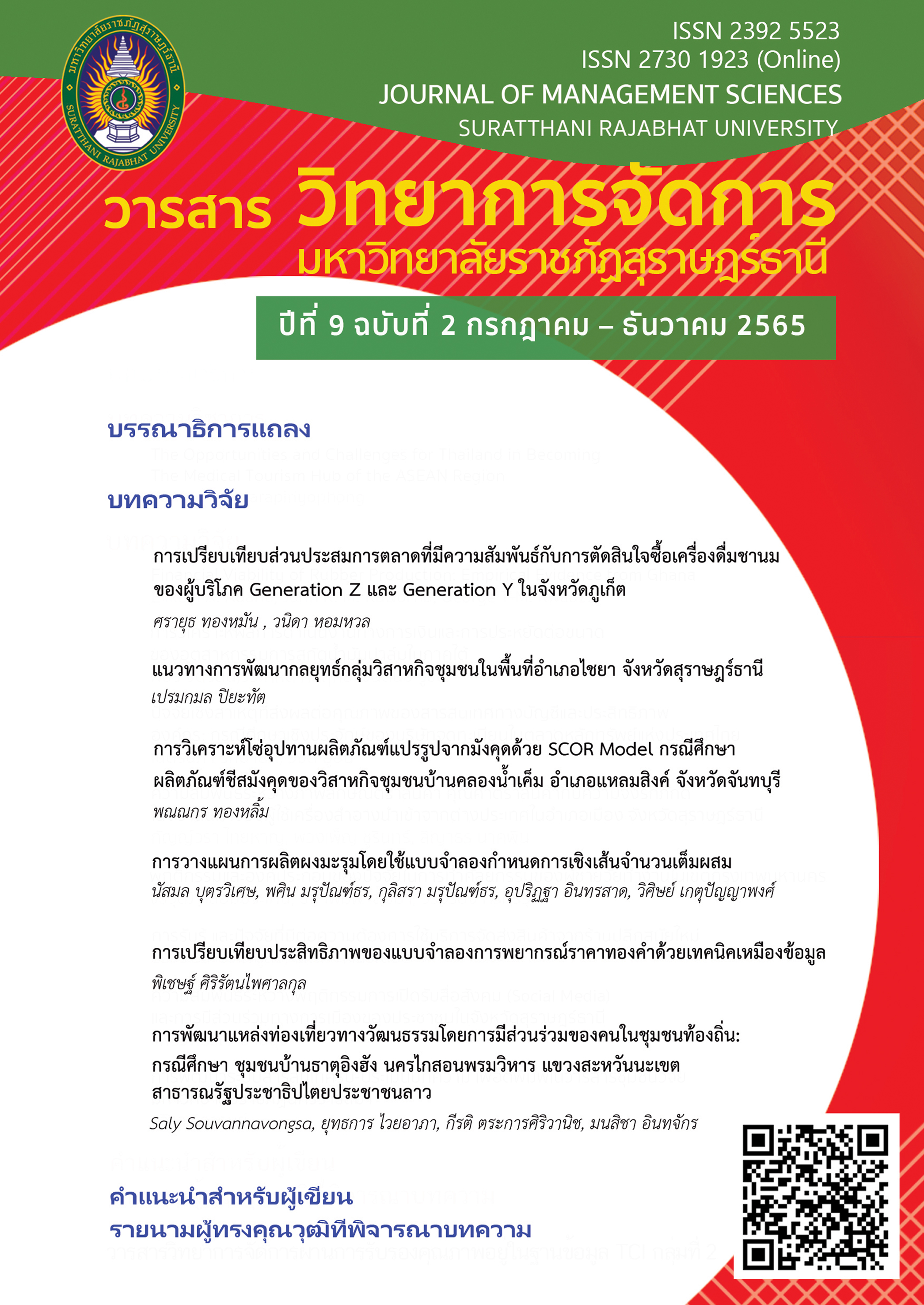การเปรียบเทียบกลยุทธ์การตลาดที่มีความสัมพันธ์กับการตัดสินใจซื้อเครื่องดื่มชานม ของผู้บริโภค Generation Y และ Generation Z ในจังหวัดภูเก็ต
Main Article Content
บทคัดย่อ
การศึกษาครั้งนี้จึงมีวัตถุประสงค์ คือ 1) เพื่อศึกษาลักษณะประชากรศาสตร์ที่มีการตัดสินใจซื้อเครื่องดื่มชานมของผู้บริโภค Generation Z และ Generation Y 2) เพื่อศึกษาการตัดสินใจซื้อเครื่องดื่มชานมของผู้บริโภค ในจังหวัดภูเก็ต และ 3) เพื่อเปรียบเทียบส่วนประสมการตลาดที่มีความสัมพันธ์กับการตัดสินใจซื้อเครื่องดื่มชานมของผู้บริโภค Generation Z และ Generation Y ในจังหวัดภูเก็ต กลุ่มตัวอย่างที่ใช้ในการวิจัย จำนวน 400 คน โดยใช้แบบสอบถามเป็นเครื่องมือในการเก็บรวบรวมข้อมูล สถิติที่ใช้ในการวิเคราะห์ข้อมูล ได้แก่ การวิเคราะห์ค่าที การวิเคราะห์ค่าความแปรปรวนทางเดียว และค่าสัมประสิทธิ์สหสัมพันธ์เพียรสัน ผลการศึกษา พบว่า 1) ผู้บริโภค Generation Z และ Generation Y ที่มีเพศ อายุ และระดับการศึกษาที่แตกต่างกัน มีการตัดสินใจซื้อเครื่องดื่มชานม ด้านราคาเครื่องดื่มชานมบาทต่อแก้วแตกต่างกัน และระดับการศึกษาที่แตกต่างกัน มีการตัดสินใจซื้อด้านการบริโภคเครื่องดื่มชานมเฉลี่ยแก้วต่อสัปดาห์แตกต่างกัน 2) การตัดสินใจซื้อเครื่องดื่มชานมของผู้บริโภค Generation Z มีการบริโภคเครื่องดื่มชานมโดยเฉลี่ยประมาณ 5 แก้วต่อสัปดาห์ ซึ่งมีราคาเครื่องดื่มชานมโดยเฉลี่ย 27 บาทต่อแก้ว สำหรับผู้บริโภค Generation Y มีการบริโภคเครื่องดื่มชานมโดยเฉลี่ยประมาณ 4 แก้วต่อสัปดาห์ ซึ่งมีราคาเครื่องดื่มชานมโดยเฉลี่ย 30 บาทต่อแก้ว 3) ส่วนประสมการตลาดมีความสัมพันธ์กับการตัดสินใจซื้อเครื่องดื่มชานมของผู้บริโภค Generation Z ด้านราคาเครื่องชานมบาทต่อแก้ว โดยมีความสัมพันธ์ในระดับต่ำและเป็นไปในทิศทางเดียวกัน โดยผู้ประกอบการควรกำหนดกลุ่มเป้าหมายให้ชัดเจน เพื่อนำผลที่ได้มาพัฒนาส่วนประสมการตลาดของชานมในจังหวัดภูเก็ตให้สอดคล้องกับการตัดสินใจซื้อในแต่ละกลุ่ม
Article Details

อนุญาตภายใต้เงื่อนไข Creative Commons Attribution-NonCommercial-NoDerivatives 4.0 International License.
เอกสารอ้างอิง
Ariffin, S.K., Ihsannuddin, N.Q, & Mohsin, A.MA. (2022). The influence of attitude functions on Muslim consumer attitude towards social media advertising: a case of bubble tea. Journal of Islamic Marketing, 13(11), 2308-2330. http://doi.org/10.1108/JIMA-01-2021-0015.
Adideal online. (2020, July 17). Consumer Behavior of Gen Z. https://adsidea.net/gen-z-%E0%B8%84%E0%B8%B7%E0%B8%Ad/.
Allied Market Research. (2020, April). Bubble Tea Market. https://www.alliedmarketresearch.com/bubble-tea-market
Bangkok bank. (2020, January 30). Penetrate the behavior of Gen Y people that brands have to deal with. https://www.bangkokbanksme.com/en/generation-y-consumer-brand-marketing.
Brandinside. (2019, October 31). A hundred million rich from bubble tea, the Alley prepares to build a new business model after the market has passed the peak. https://brandinside.asia/the-alley-rich-man/.
Entrepreneur Asia Pacific. (2019, November 9). Breakfast & beverages like bubble tea seeing hot demand on GrabFood app. https://www.entrepreneur.com/en-au/growth-strategies/breakfast-beverages-like-bubble-tea-seeing-hot-demand-on/342062.
Franzolini, B. (2020). Niche market analysis and marketing strategies applied to the Chinese market: a case study of the tea and the coffee market sold through e-commerce. [Unpublished master’s thesis]. Università Ca' Foscari Venezia.
Fröjdö, H. (2018). Feasibility of a bubble tea shop in Jakobstad: market acceptance of bubble tea. [Unpublished master’s thesis]. Centria University of Applied Sciences.
Hair, J.F., Anderson, B.W., Babin, B.J., & Anderson, R.E. (2010). Multivariate data analysis with reading. Prentice-Hall.
Iswara, C., & Rahadi, R.A. (2021). Consumer preferences and pricing model on bubble tea purchase in bandung, Indonesia. Advance International Journal of Business, Entrepreneurship and SMEs, 3(7), 111-119. http://doi.org/10.35631/AIJBES.37009.
Kaewsamdoung, J., & Jainan, A. (2020). Factors influencing the pearl milk tea business in Thailand. Thammasat Journal, 39(1), 117-130.
Kasamjit, J., & Udomsup, A. (2020). Factors related to consumer’s behavior on coffee consumption: a case study of people residing in mueang Hua Hin municipality, Prachub Khirikan. The 10th Hatyai National and International Conference (pp.1009-1022).
Kotler, P. (2003). Marketing and introduction. Pearson Education.
Kotler, P., Armstrong, G., & Opresnik, M.O. (2018). Customer value-driven marketing strategy. Principles of marketing. (pp.212-213). Pearson.
Kumar, N., & Ray, S. (2017). Attitude towards soft drinks and its consumption pattern: a study of Gen Y consumers of India. British Food Journal, 120(2), 355-366.
Kunthalbutr, S. (2009). Modern principle of marketing. Chulalongkorn University.
Lovelock, C.H., & Wirtz, J. (2011). The extended services marketing mix for managing the customer interface. In S. Yagan (Ed.). Services marketing People, technology, strategy). Pearson.
Marketeeronline. (2019, October 30). Bubble tea market. https://marketeeronline.co/archives/128557.
Mingkwansakul, C., & Wongkangwan, A. (2020). Marketing mix factors, perceived brand equity affecting behavior in purchase of “Nobicha” brand pearl milk tea of consumer in Bangkok metropolis. Journal of the 11th national and international conference and research presentation, Suan Sunandha Rajabhat University, 414- 426.
Nguyen, Q. (2020). Engaging generation Z customers in coffee house industry; comparative analysis of the Vietnamese and Finnish markets. [Unpublished master’s thesis]. Centria University of Applied Sciences.
Ong, A.K.S., Prasetyo, Y.T., Libiran, M.A.D.C., Lontoc, Y.M.A., Lunaria, J.A.V., Manalo, A.M., Miraja, B.A., Young, M.N., Chuenyindee, T., Persada, S.F., & Perwira, R.A.A.N. (2021). Consumer preference analysis on attributes of milk tea: a conjoint analysis. Approach. Foods, 10(6), 1382. https://doi.org/10.3390/foods10061382.
Phichitchumphon, S., & Charutawephonnukoon, P. (2020). Marketing mix factors and consumer behavior influencing the decision to buy bubble tea drink of KAMU brand for consumers in Central Plaza West Gate. The 7th RMUTT global business and economic national conference business challenges RTBEC 2020 (pp.245-258).
Ping, L., Jang, W., & Pan, Y. (2021). Study on the Evolution pattern of Tea Industry Service Mode: Focusing on the Needs of Each Generation in Guangxi, China. Journal of the Korea Convergence Society, 12(6), 65–74. https://doi.org/10.15207/JKCS.2021.12.6.065.
Prasootsangjan, B., & Nilrattananon, L. (2018). Factors influencing of the decision to buy health and beauty drink products. Journal of Mass Communication Technology, RMUTP, 3(1), 26-35.
Puengkasikorn, N., & Charutawephonnukoon, P. (2020). Service Marketing mix factors affecting the decision to purchase bubble milk tea at KAMU tea of consumer in Bangkok and the Metropolitan region. Conference: National Conference in Innovative Business and Entrepreneurship 2020 (NCIBE-2020) (pp.886 – 917).
Rungruangphon, W. (2015). Principle of marketing. Thammasat University.
Silcharu, T. (2008). Research and statistical data analysis with SPSS. Business R&D.
Thailand Creative and Design Center. (2020, September 19). Penetrating World Trends 2020. https://web.tcdc.or.th/media/publication_lang_file/207/TREND_2020_17-09-2019.pdf.
Thiangkratok, W., & Chaiyasoonthorn, W. (2019). Service marketing mix affecting consumer behavior of international brands bubble milk tea in Bangkok. Journal of Administration and Management, 9(2), 181 – 194.
Wongnai. (2020, June 22). 30 Pearl Tea Shops in Phuket, So sticky that you can't stop eating!. https://www.wongnai.com/listings/bubble-milk-tea-phuket.
Yokchom, N. (2019). The decision-making process of consuming bubble tea drinks of the population in Bangkok. [Unpublished master’s thesis]. Ramkhamhaeng University.


